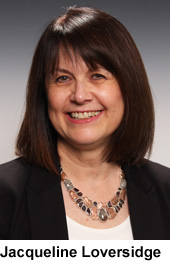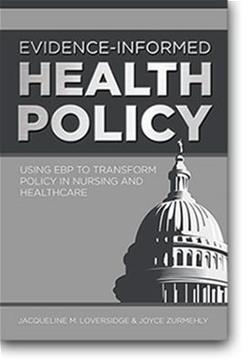The editor of RNL interviews the authors.
 Jacqueline Loversidge and Joyce Zurmehly, co-authors of Evidence-Informed Health Policy, respond to questions from James Mattson, editor of Reflections on Nursing Leadership (RNL).
Jacqueline Loversidge and Joyce Zurmehly, co-authors of Evidence-Informed Health Policy, respond to questions from James Mattson, editor of Reflections on Nursing Leadership (RNL).
RNL:
Jean Johnson, dean emerita and professor at George Washington University School of Nursing, states that Evidence-Informed Health Policy is “a book that needed to be written.” The title of your book suggests that applying evidence to policy formulation is what sets it apart. How does the approach you advocate in this book differ from other approaches, and how does it contribute to enactment of better health policies?
 Jacqueline Loversidge and Joyce Zurmehly:
Jacqueline Loversidge and Joyce Zurmehly:
First, we are honored by Dean Johnson’s remark about the book! We are privileged to join the many other authors in nursing and healthcare who have written strong and essential health policy texts, each of which views the topic through a somewhat different lens. But Dr. Johnson is correct. What distinguishes this book from others is that, to our knowledge, it is the first book written for nurses and other healthcare professionals that explicitly uses a modified form of evidence-based practice [EBP]—a process that improves clinical practice and outcomes—to transform health policy.
 Use of evidence to inform health policymaking is not new. Nursing’s regulatory environment has been a leader in this regard. For example, the stated mission of the National Council of State Boards of Nursing includes the phrase “to promote evidence-based regulatory excellence for patient safety and public protection.” For decades, health policy scientists have advocated use of evidence in policymaking. Relatively recently, Paul Ryan, former speaker of the U.S. House of Representatives, co-sponsored with Senator Patty Murray of Washington the Foundations for Evidence-Based Policymaking Act (H.R.4174) and the Protect Health Care for Retired Safety Officers Act (S.2046), which was signed into law in January 2019. Although this law focuses broadly on use of evidence to guide policymaking and not exclusively on health policy, it underscores the importance of using evidence in policymaking.
Use of evidence to inform health policymaking is not new. Nursing’s regulatory environment has been a leader in this regard. For example, the stated mission of the National Council of State Boards of Nursing includes the phrase “to promote evidence-based regulatory excellence for patient safety and public protection.” For decades, health policy scientists have advocated use of evidence in policymaking. Relatively recently, Paul Ryan, former speaker of the U.S. House of Representatives, co-sponsored with Senator Patty Murray of Washington the Foundations for Evidence-Based Policymaking Act (H.R.4174) and the Protect Health Care for Retired Safety Officers Act (S.2046), which was signed into law in January 2019. Although this law focuses broadly on use of evidence to guide policymaking and not exclusively on health policy, it underscores the importance of using evidence in policymaking.
In our book, we begin with a thorough rationale for such an approach. We remind nurses and other health professionals of their competency in EBP and how that strength applies to health policymaking. After providing a strong grounding in government structure and function, we introduce the Evidence-Informed Health Policy Model, an adaptation of the Melnyk & Fineout-Overholt EBP Model. Each step of the process is thoroughly explained, and we provide examples and strategy tools. The book includes governmental and nongovernmental resources, as well as exemplars of evidence-informed policymaking from around the globe. Our hope is that this grounded, step-by-step approach, buttressed with clear examples, resonates with readers who, like us, appreciate a practical style.
RNL:
This question is for you, Dr. Loversidge. You began your nursing education in a hospital diploma program. You are now an associate professor of clinical nursing at The Ohio State University and have been educating undergraduate and graduate students about health policy and regulation for more than 15 years. You have also served as associate executive director of the Ohio Board of Nursing. How have regulatory influences affected classroom teaching of evidence-based practice in recent decades, and how have those changes positively affected the development of effective health policy?
Loversidge:
That is a great question! The primary way in which regulatory influences have affected classroom teaching of evidence-based practice is largely dependent on the state and nurse practice acts and regulations. First, some practice acts are changing to include EBP—either directly or via description—in the definition of practice, although that is evolving. State nursing boards also regulate prelicensure nursing education, and many of those regulations now include teaching of evidence-based practice as a curriculum requirement.
 For example, Ohio regulations, in describing that state’s curriculum requirements for RN programs, stipulate that courses include “the exercise of clinical judgment, using evidence-based practice, to integrate increasingly complex knowledge, skills, and technologies as they relate to the patient” (OAC, Chapter 4723-5 Nursing Education Programs). The National Council of State Boards of Nursing (NCSBN) also addresses EBP in its 2019 test plan. Therefore, whether or not state requirements are explicit with regard to EBP curriculum content, nursing educators know they must address EBP if their graduates are to pass the National Council Licensure Examination, otherwise known as NCLEX-RN.
For example, Ohio regulations, in describing that state’s curriculum requirements for RN programs, stipulate that courses include “the exercise of clinical judgment, using evidence-based practice, to integrate increasingly complex knowledge, skills, and technologies as they relate to the patient” (OAC, Chapter 4723-5 Nursing Education Programs). The National Council of State Boards of Nursing (NCSBN) also addresses EBP in its 2019 test plan. Therefore, whether or not state requirements are explicit with regard to EBP curriculum content, nursing educators know they must address EBP if their graduates are to pass the National Council Licensure Examination, otherwise known as NCLEX-RN.
In our book, we talk not only about government policy, or “big P” (which includes government regulation), but also “little p”—policies that, while not needed to meet legal requirements, are nevertheless significant. For example, nursing program accreditation is technically voluntary in that it is not required by law and, therefore, falls in the category of “little p.” However, accreditation standards have tremendous influence on nursing education curricula. All major nursing education accreditation organizations mention health policy in their curricula requirements in some way and provide guidance for nurse educators at all levels.
It is hoped that these changes affect development of effective health policy in the following ways: As new nurses graduate, they will be better prepared to influence lawmakers as constituents, members of professional organizations, and board members. As they offer testimony, they will be capable of referencing evidence to underpin personal and professional stories, thus adding to their credibility. National nursing associations have been skilled at this level for many years. We hope this book makes these skills more accessible to emerging health policy advocates.
RNL:
Dr. Zurmehly, you are also an expert on the topic of nursing program regulation. You’ve collaborated with the National Council of State Boards of Nursing and with educators in coming up with innovations that have improved nursing education. From that 30,000-foot perspective, how has evidence-based practice changed nursing practice, and how have those changes affected healthcare and organizational health policy?
Zurmehly:
Healthcare organizations are under pressure from regulatory agencies, and because of the evolution of pay-for-performance, are increasingly focusing on quality as a sustainable outcome. Naturally, nurses are affected by these demands. Nursing is evolving beyond traditional strategies for addressing practice problems and making clinical decisions—which drew from applied knowledge and skills acquired from various sources such as instruction, tradition, standard ritual, and often personal preference—to include evidence-based care. Evidence-based practice is now taught across nursing education programs and applied in nursing care to an extent that exceeds previous efforts to introduce a new practice culture based on science. The profession has come to embrace EBP, thus filling the gap between what is known from research and how to apply that knowledge in caring for patients. As a result, nursing practice is being transformed—from care based on traditional knowledge and skill to care that routinely incorporates evidence.
In spite of these significant advances, as nurses become more knowledgeable and more proficient in incorporating evidence into practice, the challenge remains: How do we sustain best practice at a policy level? We do this by leading the way in evidence-informed policymaking.
As stakeholders, constituents, and policymakers continue to focus on quality, many healthcare organizations continue to regard practice and policy as separate concepts. In fact, this could not be farther from reality, as we illustrate in our book with the Evidence-Informed Health Policy Model for Nursing. It’s a practical model where evidence is summarized, interpreted, and applied to policymaking and clinical decision-making. We also discuss how evidence-informed policymaking differs from evidence-based practice, given the nature of the policymaking environment. However, to sustain quality care outcomes, evidence-based practice and evidence-informed health policy must coexist.
For example, the policy report titled “9 Ways to Make Federal Legislation Evidence-Based: 2019 What Works Guide for Congress” is an excellent example of how the U.S. Congress can ensure laws are passed based on evidence. Awareness of this information helps nurses and other healthcare professionals become more effective in advancing policy through the smart use of legitimate evidence.
Have evidence-based practice and health policy influenced nursing practice? Yes! Has this change improved healthcare and policy outcomes? Certainly! Just read our book, and you’ll see!
RNL:
What are some features of Evidence-Informed Health Policy that readers who want to become more effective formulators and advocates of good health policy will find particularly helpful?
Loversidge and Zurmehly:
The book provides strategy tools, real-world examples, and ways to access resources that will help readers who want to become better users of evidence to inform and advocate for good health policy. For instance, in healthcare, we know precisely how to classify and judge evidence using the evidence pyramid and a body of evidence as a basis—as in evidence-based practice—for sound clinical practice change. Policy and politics, on the other hand, are less straightforward. Lawmaker points of view, pressure from constituents and other stakeholders, and a myriad of other influences all impact how evidence is used in health policymaking. The best we can hope for is that evidence will inform dialogue and help leverage the resulting policy. Thus, we refer to the process whereby evidence is used to underpin policy change as evidence-informed.
We offer practical suggestions for planning a policy agenda and accessing evidence-informed health policy resources. We identify useful government websites. We explain how to analyze the immediate policymaking environment, including stakeholders. For example, we show how to identify opponents with whom nurses have to negotiate, as well as how to determine the strength of political forces “for or against” an issue. Illustrations that accompany our explanations will help readers who want to analyze the policymaking environment in which they seek to advance good health policy.
Some of the strategy tools provided in the book include examples of differentiating between clinical and health policy PICOT questions, along with sample policy-related PICOT questions. Since we use PICOT questions for analysis as well as for driving literature searches, a strategy tool in the book helps the reader understand the latter usage. We also provide strategy tools for giving testimony that includes evidence and for writing short policy briefs.
Each of the strategies and tools follows the Evidence-Informed Health Policy Model’s step-by-step approach. Near the end of the book, we address some of the most relevant challenges and strategies policy influencers will face, including achieving consensus within nursing with regard to a forward-facing policy agenda, ground rules for running “good” meetings, engaging with political stakeholders, and functioning in complex political systems. RNL
Jacqueline M. Loversidge, PhD, RNC-AWHC, and Joyce Zurmehly, PhD, DNP, RN, NEA-BC-ANEF, are associate professors of clinical nursing at The Ohio State University College of Nursing in Columbus, Ohio, USA.
Read related article in RNL: “Not your usual health policy center.”
Check out “Extending the use of evidence-based practice to health policymaking,” a sample chapter from Evidence-Informed Health Policy.
Click here to purchase Evidence-Informed Health Policy.